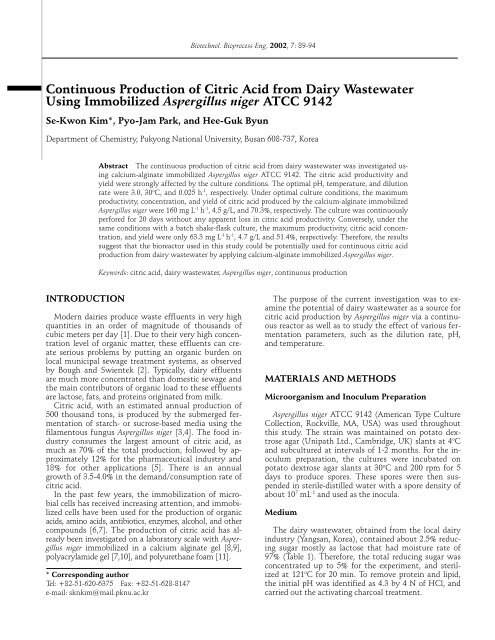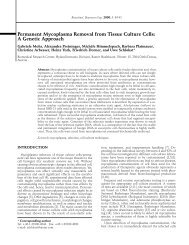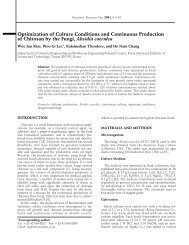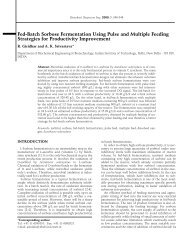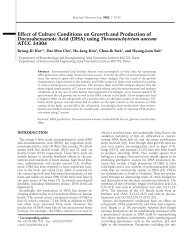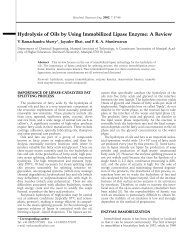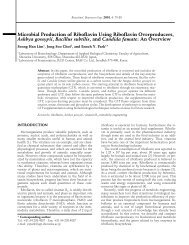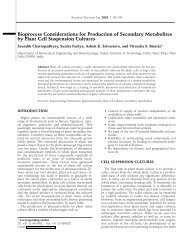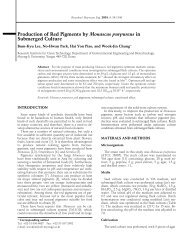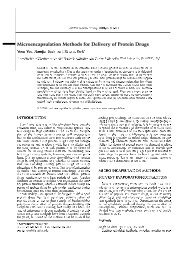Continuous Production of Citric Acid from Dairy Wastewater Using ...
Continuous Production of Citric Acid from Dairy Wastewater Using ...
Continuous Production of Citric Acid from Dairy Wastewater Using ...
You also want an ePaper? Increase the reach of your titles
YUMPU automatically turns print PDFs into web optimized ePapers that Google loves.
Biotechnol. Bioprocess Eng. 2002, Vol. 7, No. 2 91(a)maximum production <strong>of</strong> citric acid by Aspergillus foetidusin a single-stage continuous culture was at a pH <strong>of</strong>around 3.4.Effect <strong>of</strong> Temperature on <strong>Citric</strong> <strong>Acid</strong> <strong>Production</strong>(b)Fig. 3. Effect <strong>of</strong> temperature on continuous citric acid production(a) and amount <strong>of</strong> residual reducing sugar (b) at pH3.0 and 0.450 h -1 dilution rate <strong>from</strong> dairy wastewater by immobilizedAspergillus niger ATCC 9142.Fig. 2. The citric acid concentration and yield werehighest at pH 3.0 (Fig. 2(a)), yet the consumption <strong>of</strong>sugar was highest at pH 2.0 (Fig. 2(b)). These resultsagree with those <strong>of</strong> Kim et al. [14] who studied the effects<strong>of</strong> pH on citric acid production <strong>from</strong> concentratedmilk-wastewater by Aspergillus niger. This would seemto suggest that the pH did not directly influence thecitric acid production mechanism, but rather affectedthe enzymes which were active in degrading the substrateand/or the permeability <strong>of</strong> the cell membrane <strong>of</strong>the substrate and product.In general, a low pH is essential for achieving themaximum production <strong>of</strong> citric acid [15]. Shadafza et al.[16] reported that a low initial pH has the advantage <strong>of</strong>checking contamination and inhibiting oxalic acid formation.At pH 4 or above, the formation <strong>of</strong> oxalic acidis accelerated in a medium with a high buffering capacity[17]. A pH <strong>of</strong> 2.2 has been reported to be the optimumfor the growth <strong>of</strong> a mould in addition to the production<strong>of</strong> citric acid [18], whereas a higher pH (5.4 and6.0-6.5) has been found to be the optimum level for citricacid production in a molasses medium [19]. In addition,Kristiansen and Sinclair [20] reported that theTemperature is also an important factor for citric acidproduction. The effect <strong>of</strong> temperature on the citric acidproduction and residual sugar <strong>from</strong> the dairy wastewaterwhen using immobilized Aspergillus niger ATCC9142 is shown in Fig. 3(a) and (b). The maximal citricacid production was obtained at 30 o C. The yields andproductivities <strong>of</strong> citric acid at 25, 30, and 35 o C were23.7, 58.9, and 25.7%, and 100, 250 and 96 mg/L⋅h, respectively(data not shown). Kopper et al. [21] recommendedthat a temperature between 25 and 30 o C helpsto obtain high yields and rapid rates <strong>of</strong> accumulation <strong>of</strong>citric acid. At higher temperatures, the fermentationprocess is very rapid and abundant mycelial growthoccurs, consuming large amounts <strong>of</strong> sugar and thuslowering the yield <strong>of</strong> citric acid. Conversely, at lowertemperatures, higher yields <strong>of</strong> citric acid are possible, byprolonging the fermentation process [9]. Eikmeier andRehm [8], and Roukas and Kotzekidou [22] reportedthat the optimal condition for cirtic acid production byimmobilized Aspergillus niger was 30 o C. In addition,Roukas [23] reported the citric acid concentration increasedsignificantly with an increase in the fermentationtemperature <strong>from</strong> 25 to 30 o C and then decreasedabove 30 o C, plus Szewczyk and Myszka [24] studiedthe effect <strong>of</strong> temperature on Aspergillus niger growth insolid-state fermentation and found that temperaturedid not have strong a affect on the growth rate within arange <strong>of</strong> 28-34 o C. In the current study, the optimaltemperature for citric acid production was found to be30 o C when the fermentation was with immobilizedconidia. This result agrees with that <strong>of</strong> Hang and Woodams[25] who studied the effect <strong>of</strong> temperature oncitric acid production <strong>from</strong> grape pomace by solid-statefermentation, and Roukas [23] who studied the effect<strong>of</strong> temperature on citric acid production <strong>from</strong> carobpods by solid-state fermentation.Effect <strong>of</strong> Dilution Rate on <strong>Citric</strong> <strong>Acid</strong> <strong>Production</strong>The dilution rate is the medium flow rate per effectivereactor volume. Fig. 4 shows the effect <strong>of</strong> the dilutionrate on the citric acid production <strong>from</strong> the dairywastewater when using immobilized Aspergillus niger.The optimum citric acid productivity and yield were160 mg L -1 h -1 and 70.3% at a dilution rate <strong>of</strong> 0.025 h -1(Fig. 4 and Table 2). However, the yield <strong>of</strong> citric aciddecreased when the dilution rate fell below 0.010 h -1because the sugar consumption rate decreased with adilution rate. These results are similar to those reportedby Rymowicz et al. [26] who studied the effect <strong>of</strong> thedilution rate on citric acid production <strong>from</strong> glucose bycalcium-alginate immobilized Yarrowia lipolytica A-101yeast in continuous air-lift cultivations. Kristiansen andSinclair [20] reported that the maximum productivity
92 Biotechnol. Bioprocess Eng. 2002, Vol. 7, No. 2(a)(a)(b)(b)Fig. 4. Effect <strong>of</strong> dilution rate on continuous citric acid production(a) and amount <strong>of</strong> residual reducing sugar (b) at 30 o Cand pH 3.0 <strong>from</strong> dairy wastewater by immobilized Aspergillusniger ATCC 9142.Table 2. Effect <strong>of</strong> dilution rate on yield <strong>of</strong> citric acid and productivity<strong>from</strong> dairy wastewater using immobilized Aspergillusniger at 30 o C and pH 3.0 after 9 daysDilution rate (h -1 ) Yield (%) Productivity (mg L -1 h -1 )0.0100.0250.45029.570.358.931160250<strong>of</strong> citric acid by Aspergillus foetidus in a single-stagecon-tinuous culture was 0.43 kg/L⋅h at a dilution rate <strong>of</strong>0.075 h -1 , and Dawson et al. [27] reported that the optimaldilution rate was 0.017 h -1 . Gupta and Sharma[28] were reported that the optimal dilution rate for thecontinuous production <strong>of</strong> citric acid <strong>from</strong> sugarcanemolasses was 0.015 h -1 .Comparison <strong>of</strong> <strong>Citric</strong> <strong>Acid</strong> <strong>Production</strong> betweenShake-Flask and <strong>Continuous</strong> FermentationThe major objective <strong>of</strong> cell immobilization technol-Fig. 5. Comparison <strong>of</strong> continuous and shake flask cultureafter 9 and 3 days for citric acid production (a) and amount <strong>of</strong>residual sugar (b).Table 3. Comparison <strong>of</strong> citric acid production between shakeflask after 3 days and continuous fermentation after 9 daysunder optimal conditionsFermentation Yield (%) Productivity (mg L -1 h -1 )Shake-flask fermentation<strong>Continuous</strong> fermentation51.470.363.3160.0ogy is to achieve a reactor system with a high productivitythat can be maintained for extended time periods.In addition, the immobilization material should be inexpensivewhile the actual immobilization procedureand subsequent reactor operation should be simple [29].The current study attempted to improve the citric acidproductivity by a continuous fermentation process usingcalcium-alginate immobilized cells <strong>of</strong> Aspergillusniger in a bioreactor. In a batch shake-flask fermentation,the productivity (63.3 mg L -1 h -1 ) and yield (51.4%)<strong>of</strong> citric acid reached a maximum after 3 days, and thecitric acid concentration and residual sugar concentrationafter 20 days were 1.38 g/L and 8.85 g/L, respectively.Meanwhile, the yield (70.3%) <strong>of</strong> continuous cit-
Biotechnol. Bioprocess Eng. 2002, Vol. 7, No. 2 93ric acid production when using immobilized Aspergillusniger reached a maximum level after 9 days (Fig. 5). Inaddition, the productivity value (160.0 mg L -1 h -1 ) wastwice that <strong>of</strong> the batch shake-flask culture (Table 3).Dawson et al. [27] reported that the production <strong>of</strong>citric acid by Aspergilus niger in a continuous cultureincreased 2-fold when compared to a batch process.Chung and Chang [30] reported that the yield <strong>of</strong> continuouscitric acid production in a dual hollow fiberbioreactor increased about 40% when compared tobatch fermentation. In addition, Rymowicz et al. [26]reported that the productivity <strong>of</strong> citric acid produced byimmobilized Yarrowia lipolytica achieved 350 mg/L⋅h,which was about a 2.5-fold improvement when comparedto the productivity obtained in a batch processs.In conclusion, the current results reveal some importantaspects <strong>of</strong> citric acid production <strong>from</strong> dairy wastewaterby immobilized Aspergillus niger. The optimumconditions were pH, 3.0; temperature, 30 o C; and dilutionrate, 0.025 h -1 . In addition, the productivity <strong>of</strong> citricacid by the immobilized Aspergillus niger in a continuousreactor was more than two-fold higher thanthat in a the shake-flask culture. Accordingly, the resultssuggest that the bioreactor used in the current studycould be potentially used for continuous citric acid production<strong>from</strong> dairy wastewater by calcium-alginateimmobilized Aspergillus niger.REFERENCES[1] Wheatley, A. D., K. Johnson, and C. I. Winstanley (1988)The reliability <strong>of</strong> anaerobic digestion <strong>of</strong> the treatment <strong>of</strong>food processing effluents. In: E. R. Hall, P. N. Hobson,editors, Advances in Water Pollution Control, Anaerobic Digestion,pp. 135-146. Pergamon Press, Bologna.[2] Bough, W. A. and R. J. Swientek (1981) <strong>Dairy</strong> installspretreatment system vs. paying 75% <strong>of</strong> $1.5 million citytreatment plant-saves $450,000. Food Proc. 150-151.[3] Kim, S. H., Y. J. Yoo, E. Y. Kim, and M. H. Kim (1995) Effect<strong>of</strong> Aspergillus niger pellets on citric acid production ina bubble column bioreactor. J. Microbiol. Biotechnol. 5:172-176.[4] Wang, J. and P. Liu (1996) Comparison <strong>of</strong> citric acid productionby Aspergillus niger immobilized in gels and cryogels<strong>of</strong> polyacrylamide. J. Ind. Microbiol. 16: 351-353.[5] Shah, N. D., B. B. Chattoo, B. R. M. Kothari, and P. V. M.Hegde (1993) Starch hydrolysate, an optimal and economicalsource <strong>of</strong> carbon for the secretion <strong>of</strong> citric acidby Yarrow lipolytica. Starch 45: 104-109.[6] Hemachander, C., N. Bose, and R. Puvanakrishnan(2001) Whole cell immobilization <strong>of</strong> Ralstonia pickettii forlipase production. Proc. Biochem. 36: 629-633.[7] Sun, Y. and S. Furusaki (1990) <strong>Continuous</strong> production <strong>of</strong>acetic acid using immobilized Acetobacter aceti in a threephasefluidized bed bioreactor. J. Ferment. Bioeng. 69: 102-110.[8] Eikmeier, H. and H. J. Rehm (1984) <strong>Production</strong> <strong>of</strong> citricacid with immobilized Aspergillus niger. Appl. Microbiol.Biotechnol. 20: 363-370.[9] Tsay, S. S. and K. Y. To (1987) <strong>Citric</strong> acid production usingimmobilized condida <strong>of</strong> Aspergillus niger TMB 2022.Biotechnol. Bioeng. 29: 75-82.[10] Mittal, Y., I. M. Mishra, and B. S. Varshney (1993) Characterization<strong>of</strong> metabolically active development stage <strong>of</strong>Aspergillus niger immobilized in polyacrylamide gels. Biotechnol.Lett. 15: 41-46.[11] Sanroman, A., J. Pintado, and J. M. Lema (1994) A comparison<strong>of</strong> two techniques for the immobilization <strong>of</strong> Aspergillusniger in polyurethane foam. Biotechnol. Tech. 8:389-394.[12] Marrier, J. R. and M. Boulet (1958) Direct determination<strong>of</strong> citric acid in milk with improved pyridine acefic anhydridemethod. J. <strong>Dairy</strong> Sci. 41: 1683-1692.[13] Miller, G. L. (1959) Use <strong>of</strong> dinitrosalycilic acid reagent fordetermination <strong>of</strong> reducing sugars. Anal. Chem. 31: 426-430.[14] Kim, S. K., H. S. Roh, H. G. Byun, and Y. J. Jeon (1996)<strong>Citric</strong> acid production <strong>from</strong> concentrated milk-wastewaterby Aspergillus niger. Kor. J. Life Sci. 6: 6-13.[15] Grewal, H. S. and K. L. Kalra (1995) Fungal production <strong>of</strong>citric acid. Biotechnol. Adv. 13: 209-234.[16] Shadafza, T., T. Ogawa, and A. Fazeli (1976) Comparison<strong>of</strong> citric acid production <strong>from</strong> beet molasses and datesyrup with Aspergillus niger. Hakko Kogaku Zasshi 54: 65-75.[17] Usami, S. and N. Fukutomi (1977) <strong>Citric</strong> acid productionby solid state fermentation using sugarcane bagasse andconcentrated liquor <strong>of</strong> pineapple waste. Hakko KogakuZasshi 55: 44-50.[18] Srivastava, A. S. and S. K. De (1980) Effect <strong>of</strong> some culturalconditions on microbial citric acid formation. Ind. J.Agric. Chem. 13: 39-44.[19] Roukosu, A. A. and C. A. Anenih (1980) Effect <strong>of</strong> variousconditions on the production <strong>of</strong> citric acid during fermentation<strong>of</strong> molasses by A. niger. Enzyme Microb. Technol.2: 61-67.[20] Kristiansen, B. and C. G. Sinclair (1979) <strong>Production</strong> <strong>of</strong>citric acid in continuous culture. Biotechnol. Bioeng. 21:297-315.[21] Kopper, K. K., K. Chandhary, and P. Tauro (1982) <strong>Citric</strong>acid. In: G. Reed (ed.). Precott and Dunn’s Industrial Microbiology,4 th Edition, pp. 709-749. AVI Publishing Co.,Westport, CT, USA.[22] Roukas, T. and P. Kotzekidou (1986) <strong>Production</strong> <strong>of</strong> citricacid <strong>from</strong> brewery wastes by surface fermentation usingAspergillus niger. J. Food Sci. 59: 461-464.[23] Roukas, T. (1999) <strong>Citric</strong> acid production <strong>from</strong> carob podby solid-state fermentation. Enzyme Microb. Technol. 24:54-59.[24] Szewczyk, K. W. and L. Myszka (1994) The effect <strong>of</strong>temperature on the growth <strong>of</strong> A. niger in solid statefermentation. Bioprocess Eng. 10: 123-126.[25] Hang, Y. D. and E. E. Woodams (1986) Utilization <strong>of</strong>grape pomace for citric acid production by solid-statefermentation. Am. J. Enol. Vitic. 37: 141-142.[26] Rymowicz, W., H. Kautola, M. Wojtatowicz, Y. Y. Linko,and P., Linko (1993) Studies on citric acid productionwith immobilized Yarrowia lipolytica in repeated batchand continuous air-lift bioreactors. Appl. Microbiol. Bio-
94 Biotechnol. Bioprocess Eng. 2002, Vol. 7, No. 2technol. 39: 1-4.Lett. 16: 599-604.[27] Dawson, M. W., I. S. Maddox, I. F. Boang, and J. D. [29] Tisnadjaja, D., N. A. Gutierrez, and I. S. Maddox (1996)Brooks (1988) Application <strong>of</strong> fed batch culture to citric<strong>Citric</strong> acid production in a bubble-column reactor usingacid production by Aspergillus niger: The effect <strong>of</strong> dilutionrate and dissolved oxygen tension. Biotechnol. Bioeng.adsorption onto sawdust. Enzyme Microb. Technol. 19: 343-cells <strong>of</strong> the yeast Candida gulliermondii immobilized by32: 220-226.347.[28] Gupta, S. and C. B. Sharma (1994) <strong>Continuous</strong> production<strong>of</strong> citric acid <strong>from</strong> sugarcane molasses using a com-immobilization in a dual hollow-fiber bioreactor: con-[30] Chung, B. H. and H. N. Chang (1988) Aerobic fungal cellbination <strong>of</strong> submerged immobilized and surface stabilizedcultures <strong>of</strong> Aspergillus niger KCU 520. Biotechnol.tinuous production <strong>of</strong> a citric acid. Biotechnol. Bioeng. 32:205-212.[Received December 13, 2001; accepted April 16, 2002]


